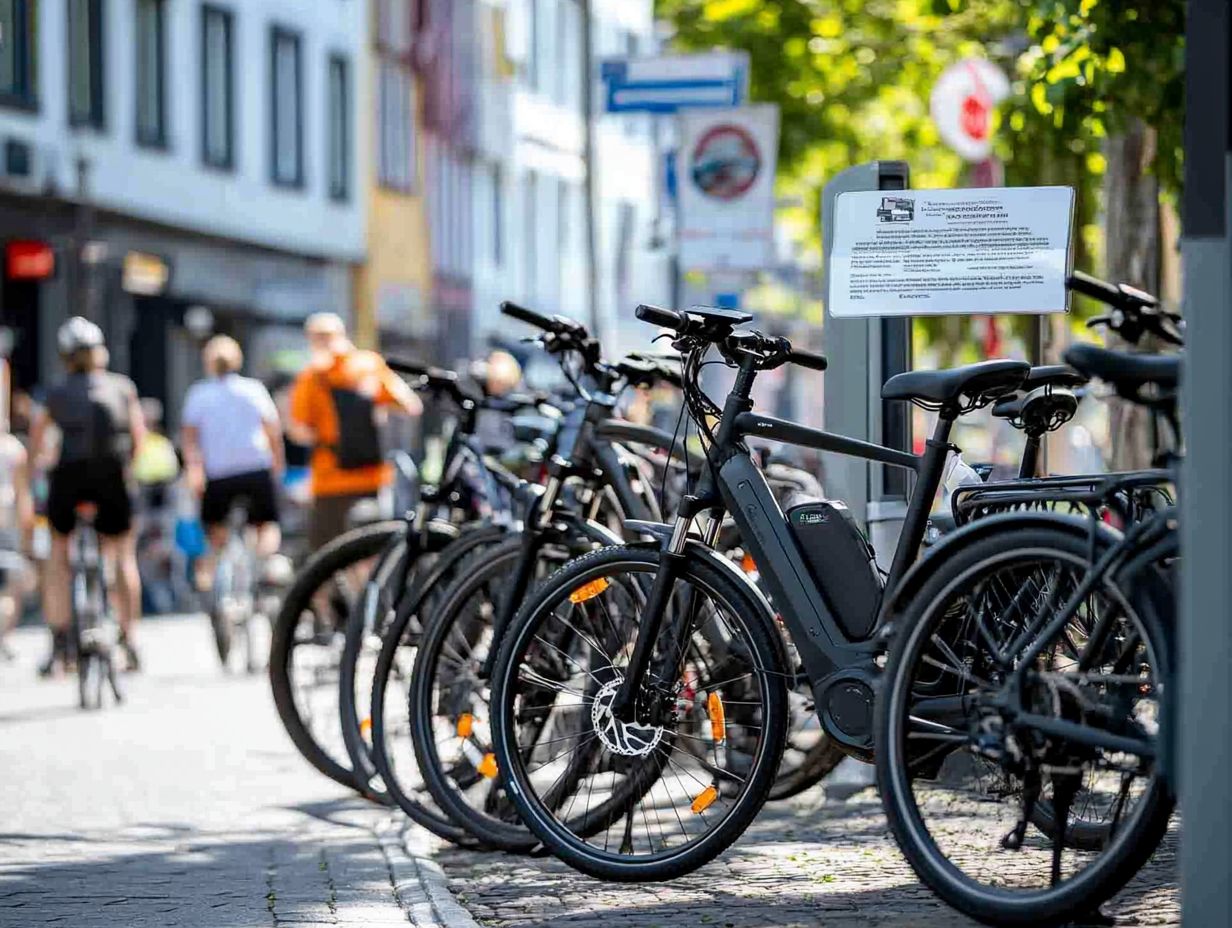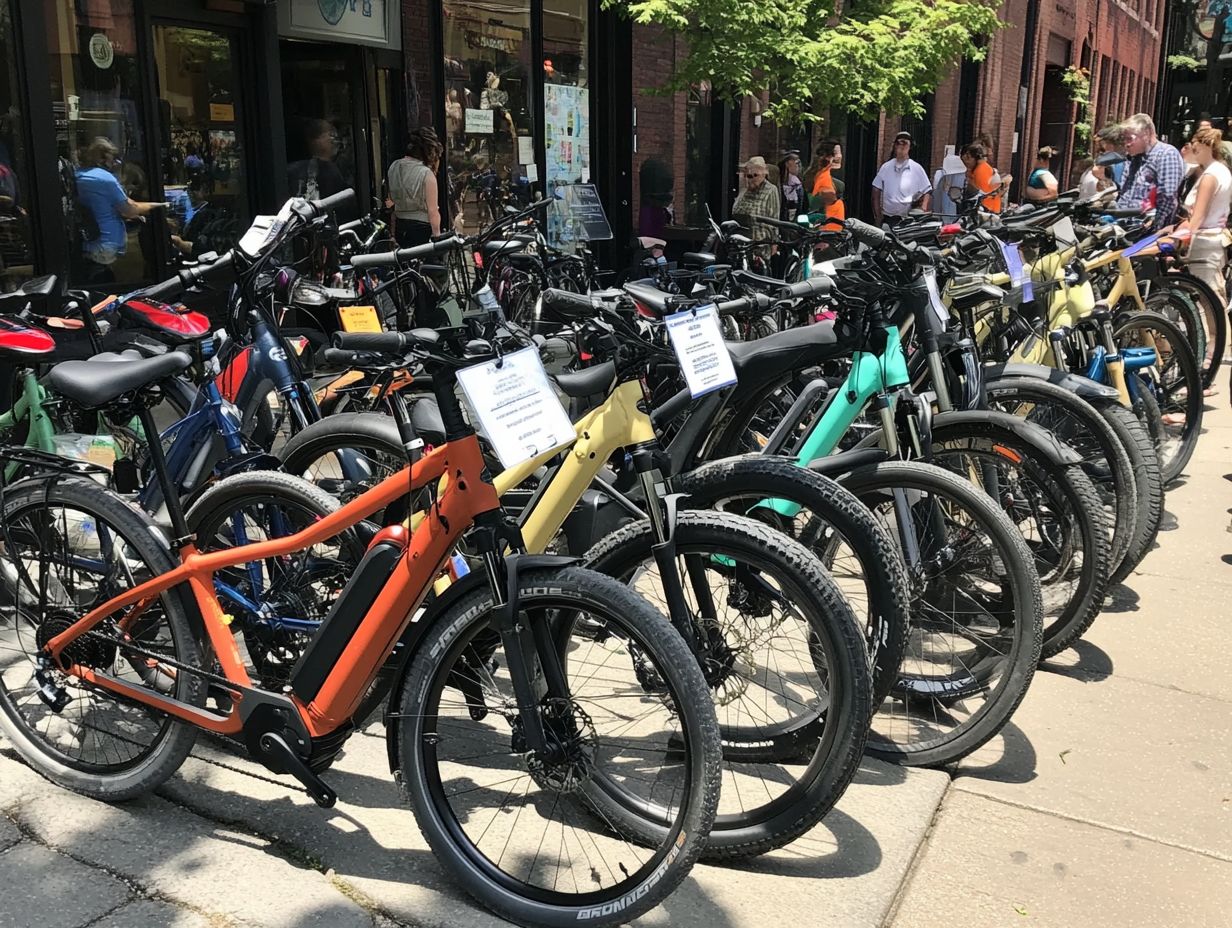Understanding the Legal Classifications of Electric Bikes
Electric bikes are changing the way we travel! They offer an eco-friendly and efficient alternative to traditional modes of transportation.
However, understanding electric bikes can be confusing, especially when it comes to their legal classifications and regulations.
This article simplifies the different classes of electric bikes. Electric bikes fall into three main categories: Class 1, Class 2, and Class 3. Each class has unique features and requirements.
This article covers important points for riders, such as licensing and insurance, ensuring you re well-informed and prepared to hit the road safely.
Contents
- Key Takeaways:
- Legal Classifications of Electric Bikes
- Class 1 Electric Bikes
- Class 2 Electric Bikes
- Class 3 Electric Bikes
- Other Considerations for Electric Bike Riders
- Frequently Asked Questions
- What are the different legal classifications of electric bikes?
- Are there any regulations or restrictions for riding electric bikes?
- Do I need a license to ride an electric bike?
- Are there any age restrictions for riding electric bikes?
- Can I ride an electric bike on bike paths or trails?
- Do I need insurance to ride an electric bike?
Key Takeaways:

- Understand the legal classifications of electric bikes, as there are different regulations at both the federal and state levels.
- Class 1 electric bikes are the most common and have specific speed and pedal-assist requirements for legal operation.
- Riders of Class 2 and Class 3 electric bikes should be aware of the differences in speed and pedal requirements, as well as any additional regulations for operating on roads and bike paths.
What are Electric Bikes?
Electric bikes, or ebikes, are a remarkable evolution in two-wheeled transportation. They seamlessly blend electric motors with pedal-assist technology to elevate your riding experience. Pedal-assist helps riders by providing extra power when pedaling.
Designed to be a sustainable alternative for daily travel, these bicycles offer benefits like eco-friendliness and unparalleled convenience.
With powerful batteries, ebikes help you conquer challenging terrains and maintain speed with significantly less effort. This makes them an enticing choice for both commuters and outdoor adventurers.
The integration of a throttle and multiple levels of pedal-assist allows you to customize your ride according to your preferences. Beyond reducing your carbon footprint, ebikes effectively serve as zero-emission motorcycles.
Their lightweight design and efficient power systems enable easy navigation through traffic. With ebikes, you can enjoy longer distances without the fatigue typically associated with standard biking. They are the perfect companion for both leisurely rides and daily commutes.
Legal Classifications of Electric Bikes
In the ever-evolving e-bike industry, grasping the legal classifications of electric bikes is essential for both riders and manufacturers. Electric bikes fall into three main categories: Class 1, Class 2, and Class 3.
Each class has unique characteristics and legal implications. These classifications are based on specific regulations, including motor power and speed limits, aimed at ensuring the safe integration of e-bikes into existing transportation systems, such as bike lanes and paths. To learn more about these classifications, check out our guide on understanding different types of electric bicycles.
Federal and State Regulations
Electric bikes operate within a complex web of federal and state regulations that govern their usage and safety standards. In the United States, the laws surrounding e-bikes vary significantly from state to state. This requires you to navigate a patchwork of local regulations, which may include registration, licensing, and safety requirements.
Federal regulations also play a role, ensuring that electric bikes meet specific criteria for proper classification and compliance with safety standards, which is crucial for understanding the mechanics of electric bikes.
State regulations often categorize e-bikes into distinct classes based on their speed and power. For example, you might encounter areas that mandate helmet use for Class 2 bikes, while others impose no such requirement. Additionally, local laws can dictate where you can ride electric bikes; some jurisdictions may permit them on bike paths but ban them from sidewalks. To learn more about how these classifications work and their implications, check out electric bike types: understanding the basics.
This regulatory maze can create confusion for riders. Failing to comply with these safety regulations can lead to fines or penalties, highlighting the necessity of understanding local laws for both compliance and consumer protection.
Ready to discover more about electric bikes? Explore the options available and find the right one for your needs!
Class 1 Electric Bikes

Class 1 electric bikes provide pedal assist only. The motor engages when you pedal, making this classification appealing for those who enjoy a traditional cycling experience.
This design encourages physical activity while delivering a smooth ride on designated bike paths and trails. With limits on motor power and speed, Class 1 ebikes access a wider array of bike lanes, making them an excellent choice for eco-friendly commuting. To learn more about different options, check out electric bicycle types.
Description and Requirements
Class 1 electric bikes come with pedal assist that activates as you pedal, ensuring a smooth and enjoyable ride without the fuss of a throttle. With a maximum motor power of 750 watts, these bikes assist you up to a speed of 20 mph, staying within local regulations.
This thoughtful design not only enhances your riding experience but also promotes a healthier lifestyle by encouraging pedaling. Familiarizing yourself with local laws is essential, as they can vary by city or state.
Wearing a helmet is a wise choice, and adding lights or reflectors significantly improves your visibility. Understanding technical specifications, such as battery capacity and range, influences both your performance and convenience.
By leveraging the pedal assist features, you not only enjoy a boost in speed but also engage in physical activity, striking a perfect balance between performance and health benefits.
Ready for a sustainable way to commute? Class 1 electric bikes can transform how you travel while supporting active transportation initiatives.
Class 2 Electric Bikes
Class 2 electric bikes grant you the luxury of throttle-only mode, allowing you to engage the motor without pedaling. This feature caters to those who appreciate a leisurely riding experience or need assistance due to mobility challenges.
Be aware that Class 2 ebikes face stricter regulations regarding where they can be used, particularly in bike lanes, as they can exceed speed limits established for traditional bicycles.
Description and Requirements
Class 2 electric bikes come with a handy throttle, letting you control the motor without pedaling. This feature offers impressive flexibility in your riding comfort.
Typically, these bikes boast a motor power of up to 750 watts, reaching speeds of 20 mph when using the throttle. This aligns perfectly with many state regulations, making them great for casual riders and anyone seeking a stress-free commute.
This throttle feature shines when you need a quick boost, whether weaving through traffic or climbing hilly terrain without breaking a sweat. The 750-watt motor efficiently provides smooth acceleration while staying within legal limits.
Understanding local regulations is essential, as some areas have specific guidelines about throttle use and speed limits on public pathways. Being aware of these enhances your overall safety and enjoyment during rides.
Class 3 Electric Bikes

Class 3 electric bikes are crafted for those who crave high-speed adventures, offering pedal assist that propels you up to 28 mph. These bikes are perfect for experienced riders and commuters prioritizing efficiency.
Equipped with robust motors, often exceeding 750 watts, they deliver an exhilarating ride along bike paths and trails. However, these bikes are governed by specific regulations that can differ by state and municipality, so staying informed is essential for a smooth journey.
Explore your options today and discover the best electric bike that fits your lifestyle!
Description and Requirements
Class 3 electric bikes stand out with their cutting-edge pedal-assist technology, enabling you to reach exhilarating speeds of up to 28 mph while you ride. These bikes are typically equipped with robust motors, often surpassing 750 watts, which means you can conquer steep hills and cover longer distances with ease.
As you enjoy this remarkable performance, it’s crucial to stay informed about local regulations regarding speed limits to ensure a safe and compliant riding experience.
Along with their powerful motors, Class 3 electric bikes often come with high-capacity batteries, providing an extended range and enhanced durability that make your rides more enjoyable. You’ll appreciate the smooth acceleration that allows you to glide effortlessly through urban landscapes or along picturesque trails. For more details, check out the electric bicycle types that suit your needs.
For enthusiasts like yourself, it’s vital to check speed limits and any additional restrictions in your area, as these can vary significantly from one region to another. Being aware of these regulations not only promotes safety but also ensures that you can fully enjoy the benefits of these innovative bikes without facing any unintended penalties.
Other Considerations for Electric Bike Riders
Riding electric bikes involves more than just examining technical specifications and classifications; it requires careful consideration of legal compliance and safety.
As a rider, you need to familiarize yourself with various requirements, including insurance, registration, and local helmet laws, all of which can vary significantly by state and municipality. By understanding these regulations, you not only ensure compliance with local laws but also enhance your protection as a consumer and elevate your overall riding safety.
Licensing and Insurance
Licensing and insurance play an important role in the legal landscape surrounding electric bikes, ensuring that you remain protected and compliant with local laws. Different states have varying requirements for registration based on the class of your ebike, and some may even require insurance to cover potential liabilities in the event of an accident.
For instance, in California, if you ride a Class 3 electric bike, you’ll need to register your vehicle. States like New York take a more relaxed stance, requiring registration only for higher-powered models. To understand the different types of bikes, refer to this quick guide on electric bicycle classification. It’s important to keep in mind that certain local municipalities might impose additional requirements, making it essential for you to consult local regulations.
This patchwork of legal frameworks means that you must stay informed about the rules in your state to ensure compliance, avoid potential fines, and prioritize your safety. Following these legal rules lets you enjoy your rides worry-free, knowing you re protected against unforeseen incidents.
Frequently Asked Questions

What are the different legal classifications of electric bikes?
The three main classifications of electric bikes are Class 1, Class 2, and Class 3. Class 1 electric bikes have a maximum assisted speed of 20 mph and are pedal-assist only. Class 2 electric bikes have a maximum assisted speed of 20 mph and can also be operated by a throttle. Class 3 electric bikes have a maximum assisted speed of 28 mph and are pedal-assist only.
Are there any regulations or restrictions for riding electric bikes?
Yes, electric bikes are subject to the same regulations and restrictions as traditional bicycles in most places. This means following traffic laws, wearing a helmet, and not riding on sidewalks. Some areas may also have specific regulations for electric bikes, so it’s important to check your local laws.
Do I need a license to ride an electric bike?
In most cases, no. Since electric bikes are classified as bicycles, they do not require a license to operate. However, there may be age restrictions for certain classes of electric bikes, so it’s important to check your local laws.
Are there any age restrictions for riding electric bikes?
It varies by the type of electric bike. Class 1 and Class 2 electric bikes do not have age restrictions, but Class 3 electric bikes may require riders to be 16 years or older. Always check your local laws to be sure.
Ready to hit the road? Make sure you’re informed and prepared for an exciting ride ahead!
Can I ride an electric bike on bike paths or trails?
Yes, you can ride electric bikes on most bike paths and trails! However, rules may vary by location.
Some areas have restrictions regarding certain types of electric bikes. Check the rules before you go!
Do I need insurance to ride an electric bike?
Usually, no insurance is required since electric bikes are treated like regular bicycles.
But if you plan to ride on public roads, protect yourself! It’s wise to have liability insurance in case of an accident.





